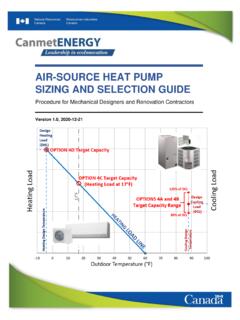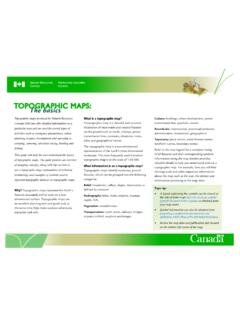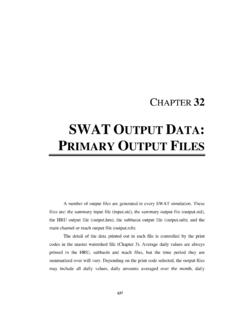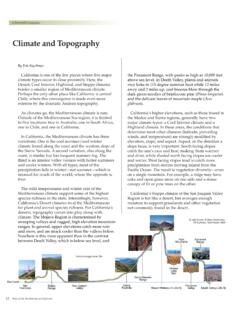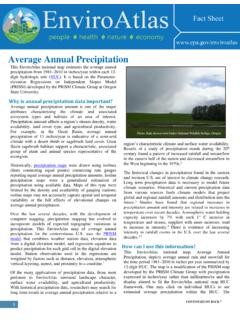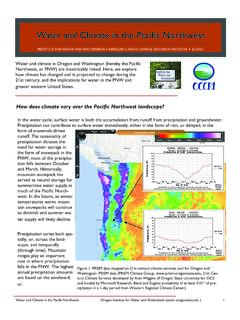Transcription of Temperature and Precipitation Across Canada
1 CHAPTER 4 Temperature and Precipitation Across CanadaCANADA S CHANGING CLIMATE REPORTCANADA S CHANGING CLIMATE REPORT 113 AuthorsXuebin Zhang, Environment and Climate Change CanadaGreg Flato, Environment and Climate Change CanadaMegan Kirchmeier-Young, Environment and Climate Change CanadaLucie Vincent, Environment and Climate Change CanadaHui Wan, Environment and Climate Change CanadaXiaolan Wang, Environment and Climate Change CanadaRobin Rong, Environment and Climate Change CanadaJohn Fyfe, Environment and Climate Change CanadaGuilong Li, Environment and Climate Change CanadaViatchelsav V.
2 Kharin, Environment and Climate Change CanadaRecommended citation: Zhang, X., Flato, G., Kirchmeier-Young, M., Vincent, L., Wan, H., Wang, X., Rong, R., Fyfe, J., Li, G., Kharin, (2019): Changes in Temperature and Precipitation Across Canada ; Chapter 4 in Bush, E. and Lemmen, (Eds.) Canada s Changing Climate Report. Government of Canada , Ottawa, Ontario, pp S CHANGING CLIMATE REPORT 114 Chapter Table Of ContentsCHAPTER KEY FINDINGS (BY SECTION)SUMMARY : Temperature Box : An example of climate data inhomogeneity : Mean Temperature : Observed changes : Causes of observed changes : Projected changes and uncertainties : Temperature extremes and other indices Observed changes Causes of observed changes Projected changes and : Precipitation : Mean Precipitation : Observed changes.
3 Causes of observed changes : Projected changes and uncertainties : Extreme Precipitation : Observed changes : Projected changes and uncertaintiesBox : The impact of combined changes in Temperature and Precipitation on observed and projected changes in fire : Attribution of extreme eventsBox : Methods for event attribution : Attribution of two recent events : 2013 Southern Alberta flood : 2016 Fort McMurray wildfireREFERENCESThis chapter assesses observed and projected changes in Temperature and Precipitation for Canada , and it presents analyses of some recent extreme events and their causes.
4 Canada S CHANGING CLIMATE REPORT 116 Chapter Key : TemperatureIt is virtually certain that Canada s climate has warmed and that it will warm further in the future. Both the ob-served and projected increases in mean Temperature in Canada are about twice the corresponding increases in the global mean Temperature , regardless of emission and seasonal mean temperatures Across Canada have increased, with the greatest warming occurring in winter. Between 1948 and 2016, the best estimate of mean annual Temperature increase is C for Cana-da as a whole and C for northern Canada .
5 While both human activities and natural variations in the climate have contributed to the observed warming in Canada , the human factor is dominant. It is likely13 that more than half of the observed warming in Canada is due to the influence of human activities. annual and seasonal mean Temperature is projected to increase everywhere, with much larger changes in northern Canada in winter. Averaged over the country, warming projected in a low emission scenario is about 2 C higher than the 1986 2005 reference period, remaining relatively steady after 2050, whereas in a high emission scenario, Temperature increases will continue, reaching more than 6 C by the late 21st warming will be accompanied by a longer growing season, fewer heating degree days, and more cool-ing degree days.
6 Extreme Temperature changes, both in observations and future projections, are consistent with warming. Extreme warm temperatures have become hotter, while extreme cold temperatures have become less cold. Such changes are projected to continue in the future, with the magnitude of change proportional to the mag-nitude of mean Temperature This report uses the same calibrated uncertainty language as in the IPCC s Fifth Assessment Report. The following five terms are used to express assessed levels of confidence in findings based on the availability, quality and level of agreement of the evidence: very low, low, medium, high, very high.
7 The following terms are used to express assessed likelihoods of results: virtually certain (99% 100% probability), extremely likely (95% 100% probability), very likely (90% 100% probability), likely (66% 100% probability), about as likely as not (33% 66% probability), unlikely (0% 33% probability), very unlikely (0% 10% probability), extremely unlikely (0% 5% probability), exceptionally unlikely (0% 1% probability). These terms are typeset in italics in the text. See chapter 1 for additional S CHANGING CLIMATE REPORT 117 : PrecipitationThere is medium confidence that annual mean Precipitation has increased, on average , in Canada , with larger percentage increases in northern Canada .
8 Such increases are consistent with model simulations of anthropo-genic climate change. annual and winter Precipitation is projected to increase everywhere in Canada over the 21st century, with larger percentage changes in northern Canada . Summer Precipitation is projected to decrease over southern Canada under a high emission scenario toward the end of the 21st century, but only small changes are project-ed under a low emission Canada as a whole, observational evidence of changes in extreme Precipitation amounts, accumulated over periods of a day or less, is lacking.
9 However, in the future, daily extreme Precipitation is projected to increase (high confidence). : Attribution Of Extreme Events Anthropogenic climate change has increased the likelihood of some types of extreme events, such as the 2016 Fort McMurray wildfire (medium confidence) and the extreme Precipitation that produced the 2013 southern Alberta flood (low confidence). Canada S CHANGING CLIMATE REPORT 118 SummaryTemperature and Precipitation are fundamental climate quantities that directly affect human and natural systems.
10 They are routinely measured as part of the meteorological observing system that provides current and historical data on changes Across Canada . Changes in the observing system, such as changes in instru-ments or changes in location of the measurement site, must be accounted for in the analysis of the long-term historical record. The observing system is also unevenly distributed Across Canada , with much of northern Canada having a very sparse network that has been in place for only about 70 years. There is very high con-fidence1 that Temperature datasets are sufficiently reliable for computing regional averages of Temperature for southern Canada14 from 1900 to present and for northern Canada2 from 1948 to present.






